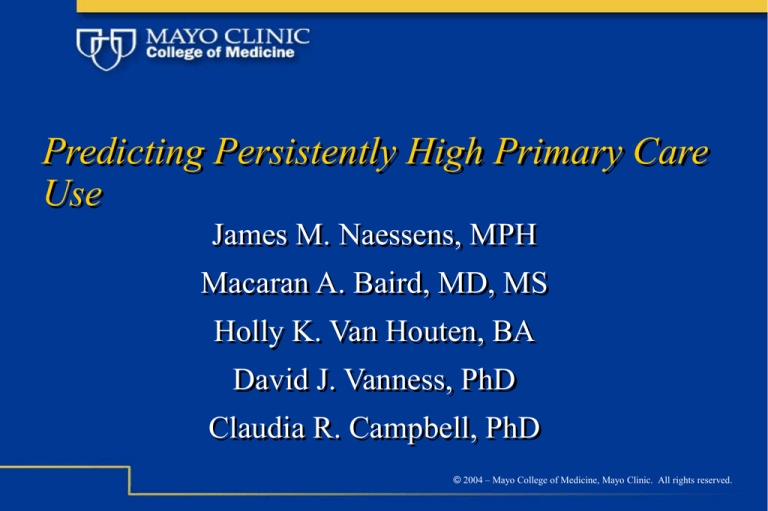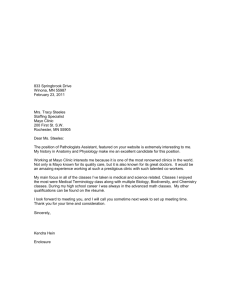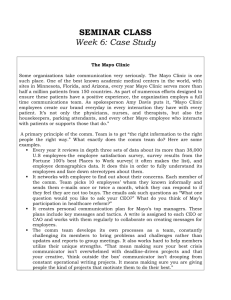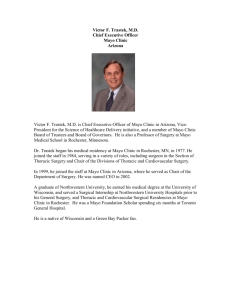Predicting Persistently High Primary Care Use
advertisement

Predicting Persistently High Primary Care Use James M. Naessens, MPH Macaran A. Baird, MD, MS Holly K. Van Houten, BA David J. Vanness, PhD Claudia R. Campbell, PhD © 2004 – Mayo College of Medicine, Mayo Clinic. All rights reserved. Identification of Costly Patients • Many factors related to high use • Patient demographics • Certain diagnoses • Chronic conditions • Disability • Severity of disease • Prior use (health care and medications) © 2004 – Mayo College of Medicine, Mayo Clinic. All rights reserved. Focus of Identification • Total health care spending • Case management • Hospitalization • Disease management © 2004 – Mayo College of Medicine, Mayo Clinic. All rights reserved. Physician Visits Employee Health Plan, 1997 50% 44% 40% 30% 20% 11% 10% 0% 0 2 4 6 # of visits Patients 8 10+ Visits © 2004 – Mayo College of Medicine, Mayo Clinic. All rights reserved. Physician Visits - Specialty Care 50% 36% 40% 30% 20% 10% 4% 0% 0 1 2 3 4 5 6 # of visits Patients 7 8 9 10+ Visits © 2004 – Mayo College of Medicine, Mayo Clinic. All rights reserved. Physician Visits - Primary Care 50% 40% 30% 18% 20% 10% 2% 0% 0 2 6 4 # of visits Patients 8 10+ Visits © 2004 – Mayo College of Medicine, Mayo Clinic. All rights reserved. Reactions • Expect a small number of individuals to have a large number of visits to specialists; however, we did not expect such concentration of visits to primary care providers © 2004 – Mayo College of Medicine, Mayo Clinic. All rights reserved. Persistence of High Primary Care Use 1997 10+ 1998 <10 PC visits 1998 10+ PC visits Pediatrics (n=152) 77.0% 23.0% Adult (n=867) 82.2% 17.8% © 2004 – Mayo College of Medicine, Mayo Clinic. All rights reserved. High Primary Care Use • A large percentage of primary care use may be incurred by patients seeking help on nonmedical issues (Lundin, 2001; Sweden) © 2004 – Mayo College of Medicine, Mayo Clinic. All rights reserved. Dr. Baird’s Questions Do we have people who are “over-serviced”, but “under-served”? Can we predict who they might be (and possibly intervene)? © 2004 – Mayo College of Medicine, Mayo Clinic. All rights reserved. Study Population • 54,074 eligible patients with research authorization • 6% of population excluded due to HIPAA and Minnesota regulations • Outpatient office visits: 1997-1999 • Primary care: • Family medicine • General internal medicine • General pediatrics • Obstetrics © 2004 – Mayo College of Medicine, Mayo Clinic. All rights reserved. Methods • Identify factors associated with “persistent, high” primary care use: • 10+ visits in two consecutive years • Develop logistic model on 1997-1998 data • Confirm model on 1998-1999 data © 2004 – Mayo College of Medicine, Mayo Clinic. All rights reserved. High Users 1997 n = 929 High Users 1998 Recurrent high use in 1998 n=163 Not eligible in 1998 n = 58 New high users in 1998 n = 947 n = 987 Not eligible in 1999 n = 10 n = 1120 © 2004 – Mayo College of Medicine, Mayo Clinic. All rights reserved. Potential Risk Factors • Age • Gender • Diagnoses • Employee/dependent status • (During timeframe: no copays, deductibles) © 2004 – Mayo College of Medicine, Mayo Clinic. All rights reserved. Clinical Risk Factors • Adjusted Clinical Groups – Johns Hopkins • Based on all diagnoses for patient in year • Clinically meaningful • Developed by medical experts in primary care • Predictive of utilization and resource costs © 2004 – Mayo College of Medicine, Mayo Clinic. All rights reserved. Going from Diagnosis Codes to ACGs Diagnosis Codes Adjusted Diagnosis Groups (ADGs): 32 Age, Gender (ACGs)-Adjusted Clinical Groups ©1998 © The Johns Hopkins University School of Hygiene andrights Public Health 2004 – Mayo College of Medicine, Mayo Clinic. All reserved. Illustrative ACG Decision Tree Entire Population ACG X ACG Y Assignment is based on age, gender, ADGs, and optionally, delivery status and birthweight ACG Z There are actually around 106 ACGs ©1998 The University School Mayo of Hygiene © Johns 2004 –Hopkins Mayo College of Medicine, Clinic.and AllPublic rights Health reserved. • To better understand what factors may be important in predicting primary care visits, we used the ADGs as our clinical risk factor © 2004 – Mayo College of Medicine, Mayo Clinic. All rights reserved. Model Results – Overall: Development 33 ADG Pregnancy Odds Ratio 0.17 95% CI (0.10,0.28) Score -4 11 Chronic Med: Unstable 2.07 (1.37,3.12) +2 30 See and Reassure 2.06 (1.24,3.41) +2 26 Signs & Sympt: Minor 1.51 (1.02,2.22) +1 23 Psychosocial: Time Limited, Minor 1.56 (1.01,2.41) +1 © 2004 – Mayo College of Medicine, Mayo Clinic. All rights reserved. % Persistent Persistent High Primary Care Use by Model Score 60 50 40 30 20 10 0 Overall Adults Peds -4 to 2 -1 0 1 2 3 4 5+ Score © 2004 – Mayo College of Medicine, Mayo Clinic. All rights reserved. Yield of Model Score - Adults • Using a score of 1 or greater • Sensitivity – 80.3% Specificity – 62.7% • Using a score of 2 or greater • Sensitivity – 50.3% Specificity – 81.2% • Area under ROC curve – 0.794 © 2004 – Mayo College of Medicine, Mayo Clinic. All rights reserved. Yield of Model Score - Pediatrics Prediction among pediatrics is not useful: • score of 1 or greater • Sensitivity - 78.3% Specificity - 29.9% • score of 2 or greater • Sensitivity - 33.3% Specificity - 75.1% © 2004 – Mayo College of Medicine, Mayo Clinic. All rights reserved. Persistence of High Primary Care Use – Confirmatory Sample 1998 10+ 1999 <10 PC visits 1999 10+ PC visits Pediatrics (n=237) 74.7% 25.3% Adult (n=873) 80.4% 19.6% © 2004 – Mayo College of Medicine, Mayo Clinic. All rights reserved. % Persistent Comparison of Model Scores 1998 vs 1999 70 60 50 40 30 20 10 0 1998 1999 -4 to 2 -1 0 1 2 3 4 5+ Score © 2004 – Mayo College of Medicine, Mayo Clinic. All rights reserved. Yield of Model Score – Adults Confirmatory Data • Using a score of 1 or greater • Sensitivity – 75.8% Specificity – 57.9% • Using a score of 2 or greater • Sensitivity – 49.8% Specificity – 80.0% • Area under ROC curve – 0.752 • New persistent – 0.713 Recurrent – 0.594 © 2004 – Mayo College of Medicine, Mayo Clinic. All rights reserved. Discussion • Unstable chronic medical conditions were predictive of continued high use. • Good candidates for disease management. © 2004 – Mayo College of Medicine, Mayo Clinic. All rights reserved. Discussion 2 • Time-limited minor psychosocial conditions, minor signs and symptoms, and see and reassure conditions were also predictive. • These “over-serviced, under-served” may benefit from alternative social support services or integrated consultations with primary care providers to better address patient needs through non-medical approaches. © 2004 – Mayo College of Medicine, Mayo Clinic. All rights reserved. Discussion 3 • Scoring model was able to consistently identify a sizeable portion of the persistent high users, but not effective among pediatric patients. © 2004 – Mayo College of Medicine, Mayo Clinic. All rights reserved. Limitations • Single group of covered employees and dependents in small urban setting in a Midwestern state. • Fee-for-service coverage with no co-payments, co-insurance or deductibles at time of study. • Limited risk factors considered. © 2004 – Mayo College of Medicine, Mayo Clinic. All rights reserved. Further Research • Family Practice team is evaluating “reflective interviews” and integrated consultations among patients with high primary care use. • Need to evaluate cost effectiveness of proposed interventions. © 2004 – Mayo College of Medicine, Mayo Clinic. All rights reserved.




